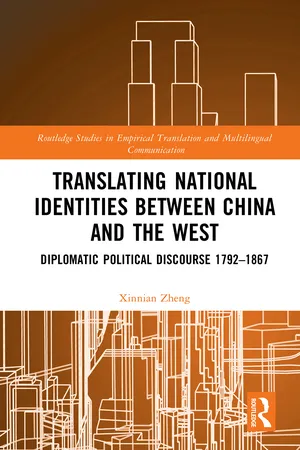
Translating National Identities Between China and the West
Diplomatic Political Discourse 1792–1867
- 264 pages
- English
- ePUB (mobile friendly)
- Available on iOS & Android
Translating National Identities Between China and the West
Diplomatic Political Discourse 1792–1867
About this book
This book explores the discursive construction of national identities in diplomatic political discourse, focusing on translation's pivotal role. It examines diplomatic exchanges between China and the West from 1792 to 1867, a period marked by China's national identity crisis. By combining Descriptive Translation Studies (DTS) with Discourse-Historical Approach (DHA), the book uncovers how translation shaped the national identities of both China and the West during a time of intercultural conflict and change.
Through the analysis of 29 authentic historical documents, the book offers a groundbreaking analysis of how translators at the Qing court initially portrayed China as superior and the West as inferior. However, as China's global position shifted, so did its translation strategies, gradually transforming China's national identity to be seen as equal to the West. During diplomatic interactions, translators played a crucial role in shaping perceptions of both Chinese and Western identities, thereby influencing international relations.
Essential for scholars and students of translation studies, political discourse, and Chinese history, this book goes beyond traditional analysis, offering a new perspective on the intricate relationship between translation, power, and identity. Its blend of qualitative and quantitative methods provides a comprehensive view of East-West relations during a pivotal period in world history.
Frequently asked questions
- Essential is ideal for learners and professionals who enjoy exploring a wide range of subjects. Access the Essential Library with 800,000+ trusted titles and best-sellers across business, personal growth, and the humanities. Includes unlimited reading time and Standard Read Aloud voice.
- Complete: Perfect for advanced learners and researchers needing full, unrestricted access. Unlock 1.4M+ books across hundreds of subjects, including academic and specialized titles. The Complete Plan also includes advanced features like Premium Read Aloud and Research Assistant.
Please note we cannot support devices running on iOS 13 and Android 7 or earlier. Learn more about using the app.
Information
Table of contents
- Cover
- Half-Title Page
- Series Page
- Title Page
- Copyright Page
- Table of Contents
- List of Figures
- List of Tables
- Acknowledgements
- List of abbreviations
- Preliminary remarks
- 1 Introduction
- 2 Contextualization: World order and national identity
- 3 Conceptual problems: Discourse, diplomatic discourse, identity, national identity, ideology
- 4 Political discourse analysis: A discursive and a translation perspective
- 5 Theoretical consideration: Descriptive translation studies and critical discourse analysis
- 6 Research design: Methodology and data processing
- 7 Corpus analysis: Translation of national affiliations and forms of address in diplomatic discourse between China and the West (1792–1867)
- 8 Conclusions
- References
- Appendices (Chronological Order)
- Index